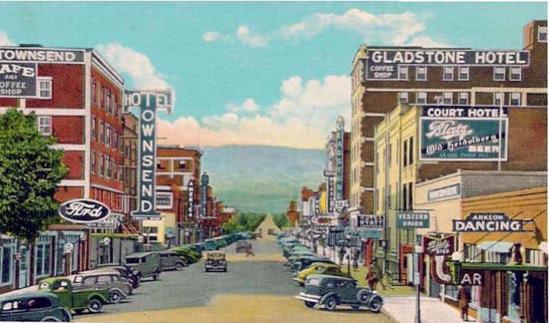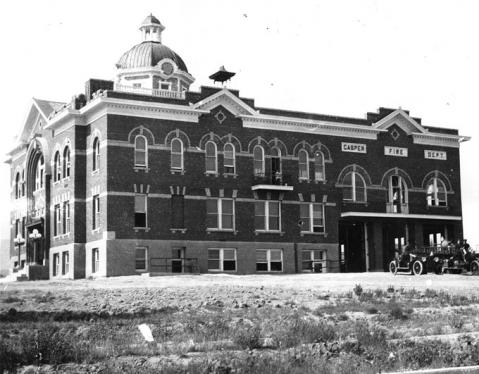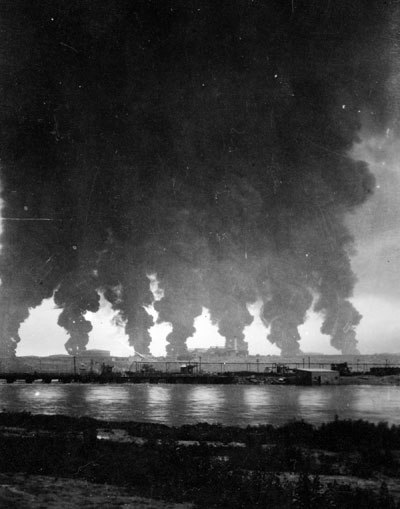- Home
- Encyclopedia
- Casper, Wyoming
Casper, Wyoming
Located at 5,150 feet above sea level, on the banks of the North Platte River on Wyoming’s high plains, Casper is the seat of Natrona County. The town began when the tracks of the Fremont, Elkhorn & Missouri Valley Railroad arrived in June 1888, and was named for nearby Fort Casper, by then a ruin. The fort had been named for Lt. Caspar Collins, killed near the fort by Indians in 1865. The Army misspelled his first name when they renamed Platte Bridge Station not long after his death.

Soon after the railroad arrived the town became an important shipping point for cattle and wool. Its earliest buildings stood about at the intersection of what are now A and McKinley streets. However, as soon as the railroad’s land company began to plat residential and business sites, people in the nascent town packed up and moved about a mile west. By the fall of 1888, the center of town was the corner of Center and Second streets, where it remains today.
On April 9, 1889, residents asked the officials of Carbon County to allow the incorporation of the town of Casper. (Natrona County would not split off from Carbon County until the following year.) The request was approved, and on July 8, 1889, voters elected George Mitchell as mayor, and Robert White, Peter Demorest, Alexander McKinney and John Adams as councilmen.
Casper was home to three county courthouses. The first, on David Street, was wood frame covered with seam iron. It cost $477 in 1895. The second, built in 1908, stood in the middle of North Center Street at A Street. The present county building went up in 1940 on Center between A and B streets.
During its first years, Casper was a rough-and-tumble town. The west side of Center Street featured numerous saloons and the raucous culture that went with them. Early law enforcement tried to keep order among rowdy cowboys, celebrating sheepherders and ever-present prostitutes.
Still, town leaders quickly set about making changes to guarantee a stable and more permanent city. A proper town needed water, streets, schools, a fire department, a library and other amenities. On July 7, 1890, the town government moved into its first home, a two-story brick building on Center Street with a large central hall and a bell tower.

By the 20th century, an expansion of the town hall became necessary as the community and the volume of town business grew. Contractors completed a new building on May 29, 1919, on the northwest corner of Center and Eighth streets.
This two-story brick structure included a wing for the fire department. For many years, the fire department was an all-volunteer company. The first paid firefighter was hired in 1912 at a salary of $100 per month. In 1920, the city built a new station on the west side David Street, north of Midwest Avenue. Law enforcement also evolved during this period, with police officers eventually replacing the town marshal.
Water was a constant problem. At first, centrally located wells provided water to residents living close to downtown. Those living further out dug their own wells. Alkali and bacteria often made the water unpalatable or unsafe. Waterborne diseases took their toll on residents, especially children. Over time, these epidemics caused the town physician and marshal to force people to clean up their properties, improving sanitation and thus improving the water supply.
In Casper’s first two decades, most of its wealth still came from agriculture, primarily from sheep and cattle ranching. The most successful ranchers built fine houses in what is still called the mansion district, south of downtown.
In the first years of the 20th century, electricity and telephones became available in town. Dr. Frederic Salathe and banker and sheep man C. H. King worked together to build a power plant adjacent to the first oil refinery, and the first electric lights from the Casper Electric Company were lighted on June 12, 1900. Telephone service began on March 22, 1902, when Rocky Mountain Bell Telephone installed 49 telephones. By 1910, there were 300 telephones; by 1925, with phone service and population booming, there were 5,600.
The high numbers of illnesses and accidents made both a hospital and a cemetery necessary. Land for Highland Cemetery was set aside on the eastern edge of Casper. Just down the road, the Casper branch of the Wyoming State Hospital, located at Second and Conwell streets, opened in 1911. This later became the Memorial Hospital of Natrona County, and later still the Wyoming Medical Center.
Casper’s earliest newspaper was the Casper Weekly Mail, first published in 1888. Editors at this and other papers came and went fairly quickly. The Natrona Tribune, for example, went through nine editors between its premier issue on June 1, 1891, and 1897, when Alfred Mokler purchased and renamed it the Natrona County Tribune.
In the early years, readers could borrow books from the Women’s Christian Temperance Union library on Center Street. In 1905, town officials contacted industrialist and philanthropist Andrew Carnegie to ask for a donation for a town library. His $10,000 gift allowed them to build a library, first operated by the town and later by the county, at its present site at Second and Durbin streets.
The potential for oil drew prospectors as early as 1888, but it was only after pioneer oilmen Cy Iba and Mark Shannon developed the first producing oil wells in the Salt Creek Field, 40 miles to the north, that Casper acquired more of the trappings of a midwestern industrial city. Shannon formed the Pennsylvania Oil and Gas Company, and in 1895 built a refinery near where Center Street crossed the railroad tracks. Oil was hauled to Casper in wagons with string teams of 12 to 18 mules.
That first refinery closed after Societé Belgo-Americain des Petroles du Wyoming acquired Shannon’s property. Belgo-American then merged with the Franco-Wyoming Oil Company. On June 11, 1912, this corporation opened a new refinery near the present intersection of Beverly and Fourth streets—well beyond the eastern edge of town at the time. That same year, the Midwest Oil Company opened a refinery on the west side of town along the North Platte River.
Casper boomed with the booming oil and refining businesses between 1910 and 1925. Workers and their families flocked in from around the nation and the world. Between 1910 and 1920, Casper’s population quadrupled—from 2,639 to 11,447. In the next decade, the population grew to 16,619—a growth of more than 600 percent in just 20 years.
Around 1916, with the oil business booming, the Sand Bar, a dodgy neighborhood just west of downtown, began to flourish. Its saloons, pool halls, cafes and brothels catered to Casper’s oilfield and refinery workers, freighters, sheepherders and cowboys. When Prohibition came to Wyoming in 1919, the Sand Bar’s saloons became speakeasies and went right on flourishing, often with local law enforcement looking the other way.

By 1922, Standard Oil of Indiana owned a controlling interest in the Midwest Refinery. That year it was the largest refinery, by volume of its gasoline production, in the world.
In 1922, Texaco began building a refinery on the river three miles east of town, and in the following year the White Eagle refinery—later owners included Little America and Sinclair oil companies—was constructed next to Texaco. The town of Evansville, now a Casper suburb, grew up near the refinery.
The Great Depression came early to Wyoming, with agricultural prices plunging immediately after World War I and oil prices falling after the mid 1920s. Casper was already suffering hard times when the Depression spread nationwide after the stock market crash of 1929.
New Deal programs such as the Civilian Conservation Corps, the Works Progress Administration and the Public Works Administration brought some welcome low-paying jobs, but only with World War II did things really begin to improve. The biggest boost came as construction of the Casper Army Air Field west of town—more than 400 buildings were built in three and a half months—provided work for hundreds. The Army Air Corps trained about 16,000 soldiers at the field, mostly bomber crews and pilots, before it closed in March 1945.
After the war, the GI Bill helped veterans pursue college degrees and buy homes. For Casper this meant new homes funded by Veteran’s Administration loans and a college that would provide the first two years of higher education. Casper Junior College opened in September 1945, on the third floor of Natrona County High School.
In the fall of 1955, the rapidly expanding two-year school, now called Casper College, moved to its present location on the hills south of downtown. The University of Wyoming started offering some four-year and a few master’s degrees on the Casper College campus beginning in the mid-1970s. The college currently enrolls around 4,000 students with a faculty of about 250.
Population pressures from the postwar baby boom, and from an oil business again growing in the 1950s brought new subdivisions to the north, west, and south of town. New businesses joined older ones, and eager businessmen took chances on the boom. Tom Stroock, John Wold and Dave True in oil and gas, Fred Goodstein in real estate and Neil McMurry in construction were just a few who turned the new frontier of opportunities into fortunes. Other businessmen developed shopping areas like Sunrise and Westridge shopping centers.
Kelly Walsh high school opened in 1965; the school district built more elementary and junior high schools as Casper continued to grow. People watched movies at the America and Rialto theaters downtown, as they had for decades. Shows broadcast by television stations KTWO and KSPR entertained them as did popular music on radio stations KTWO, KVOC and KATI. Each year the Casper Troopers Drum and Bugle Corps performed for local and national audiences. The Casper Morning Star and the Casper Tribune-Herald joined in 1965 to form the Casper Star-Tribune, which became the largest newspaper in the state and the only one distributed statewide.
As the 1970s dawned, the U.S. Census reported 39,361 residents in Casper. The energy boom of the 1970s boosted the 1980 census to 51,016, but a steep fall in oil prices shortly afterward led a number of national oil companies to close their Casper offices, and many houses and storefronts stood empty. The population fell to 46,742 by 1990.
Eastridge Mall opened in 1982 at what was the east end of East Second Street, pulling the town eastward, drawing retail customers from all over central Wyoming and at the same time harming many downtown businesses. After nearly 20 years, the downtown is again thriving. Most commercial growth continues east, however, with a two-mile extension of East Second Street now serving new medical, automotive and big-box retail businesses.
The Texaco refinery closed in 1982. Sinclair Oil continues to operate a small refinery east of Evansville, on the river next to the old Texaco site. The Amoco Refinery—successor of the early Midwest and Standard Oil refineries—closed in 1991, dealing a severe blow to Casper. These pressures forced some diversity on the local economy, but it was a 1990s boom in coalbed methane drilling in northeastern Wyoming that revitalized Casper’s drilling-services businesses. Slowly, the population began to grow again, to 49,654 by 2000, and 55,316 by 2010.
Casper continues as a retail, medical and energy-industry service hub for the surrounding region and for much of Wyoming, and has continued to grow and diversify in the 21st century. Interstate 25 and the Casper/Natrona County International Airport are the town’s major connections to the outside world.

Resources
Primary Sources
- Shallenberger, Percy H. Letters from Lost Cabin: A Candid Glimpse of Wyoming a Century Ago. Edited by Doug Cooper. Casper: Mountain States Lithographing, 2006.
Secondary Sources
- Anderson, Kevin. Spirit of the Thunderbird: The Growth of Casper College. Casper: Casper College, 1995.
- “B.P. Amoco Timeline.” Casper Star-Tribune June 22, 2005. Accessed 11/29/11 at http://trib.com/news/local/article_95dec472-b119-5f7d-8be3-740c6deaf8a1.html.
- Cronin, Vaughn. Casper. Casper: Endeavor Books, 2009.
- Garbutt, Irving. History of Casper and Natrona County, Wyoming, 1889-1989. Vol. 1. Dallas: Irving Media, 1990.
- ____________. I Was There: Recollections of Ten Decades. Casper: Casper Journal, 2003.
- Glass, Jefferson. “The Founder of Evansville: Casper Builder W. T. Evans” Annals of
- Wyoming, 70 (1998): 20-21.
- Hunt, Rebecca. Wyoming Medical Center: A Centennial History. Virginia Beach, Va.:
- Donning Press, 2011.
- ____________. Natrona County: People, Place and Time. Virginia Beach, Va.: Donning Press, 2011.
- Kukura, Edna Gorrell and Susan Niethammer True. Casper: A Pictorial History. Virginia Beach, Va.: The Donning Company, 1986.
- Johnson, Robert. A Look Backward, a Step Forward: The Quiet Impact of Fifty Years,
- City of Casper-Natrona County Health Department, 1954-2004. Casper: Mountain States Lithography, 2004.
- Jones, Walter. History of the Sand Bar (1888-1977). Casper: BASO, Inc., 1981.
- __________. A Window to the World: The First 100 Years of the Natrona County Public Library. Casper: Natrona County Public Library, 2010.
- Junge, Mark. A View from Center Street: Tom Carrigen's Casper. Casper: McMurry Foundation, 2003.
- Mead, Jean. Casper Country: Wyoming’s Heartland. Boulder, Colo.: Pruett Publishing, 1987.
- ________. Wyoming in Profile. Boulder, Colo.: Pruett Publishing, 1982.
- McDermott, John D. Frontier Crossroads: The History of Fort Caspar and the Upper
- Platte Crossing. Casper: The City of Casper, 1997.
- Mokler, Alfred J. History of Natrona County, Wyoming, 1888-1922. Chicago: Lakeside Press, 1923. Reprint, Casper: Mountain States Lithography, 1989.
- Monnett, John H. Where A Hundred Soldiers Were Killed: The Struggle for the Powder
- River Country in 1866 and the Making of the Fetterman Myth. Albuquerque: University of New Mexico Press, 2008.
- Rea, Tom. Mathew Campfield, Barber and Pioneer Survivor, accessed 11/22/11 at http://www.tomrea.net/Mathew%20Campfield.html.
- Scott, John David. Wyoming Wildcatter. Palm Beach, Fla.: Private Profile Publishers, 1985.
- Ward, Harry Arundel. Register: The Story of Casper’s Irish Colony. Plainfield, Ill.: Bantry Publications, 2002. Available on computer disk or online; accessed 11/30/11 at http://www.casperirish.com.
- Wyoming State Historic Preservation Office, National Register of Historic Places. “Casper Army Air Base,” accessed 12/2/11 at http://wyoshpo.state.wy.us/NationalRegister/Site.aspx?ID=273.
Illustrations
- The image of Center Street about 1938 is from Wyoming Tales and Trails. Used with thanks.
- The photos of Casper’s second city hall and of the oil tank fire are both from the Chuck Morrison Collection, Casper College Western History Center. Used with thanks.
- The photo of Casper today is by Tom Rea.
